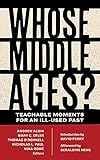Whose Middle Ages? : Teachable Moments for an Ill-Used Past / ed. by Andrew Albin, Mary C. Erler, Thomas O'Donnell, Nicholas L. Paul, Nina Rowe.
Material type: TextSeries: Fordham Series in Medieval StudiesPublisher: New York, NY : Fordham University Press, [2019]Copyright date: ©2019Description: 1 online resource (240 p.) : 35Content type:
TextSeries: Fordham Series in Medieval StudiesPublisher: New York, NY : Fordham University Press, [2019]Copyright date: ©2019Description: 1 online resource (240 p.) : 35Content type: - 9780823285594
- 909.07 23
- CB351 .W47 2019eb
- online - DeGruyter
| Item type | Current library | Call number | URL | Status | Notes | Barcode | |
|---|---|---|---|---|---|---|---|
 eBook
eBook
|
Biblioteca "Angelicum" Pont. Univ. S.Tommaso d'Aquino Nuvola online | online - DeGruyter (Browse shelf(Opens below)) | Online access | Not for loan (Accesso limitato) | Accesso per gli utenti autorizzati / Access for authorized users | (dgr)9780823285594 |
Frontmatter -- Contents -- Introduction -- Part I - Stories -- Introduction -- The Invisible Peasantry -- The Hidden Narratives of Medieval Art -- Modern Intolerance and the Medieval Crusades -- Blood Libel, a Lie and Its Legacies -- Who's Afraid of Shari'a Law? -- How Do We Find Out About Immigrants in Later Medieval England? -- The Middle Ages in the Harlem Renaissance -- Part II - Origins -- Introduction -- Three Ways of Misreading Thomas Jefferson's Qur'an -- The Nazi Middle Ages -- What Would Benedict Do? -- No, People in the Middle East Haven't Been Fighting Since the Beginning of Time -- Ivory and the Ties That Bind -- Blackness, Whiteness, and the Idea of Race in Medieval European Art -- England Between Empire and Nation in "The Battle of Brunanburh" -- Whose Spain Is It, Anyway? -- Part III - #Hashtags -- Introduction -- Modern Knights, Medieval Snails, and Naughty Nuns -- Charting Sexuality and Stopping Sin -- "Celtic" Crosses and the Myth of Whiteness -- Whitewashing the "Real" Middle Ages in Popular Media -- Real Men of the Viking Age -- #DeusVult -- Own Your Heresy -- Afterword: Medievalists and the Education of Desire -- Appendixes -- Appendix I: Possibilities for Teaching-By Genre -- Appendix II: Possibilities for Teaching- by Course Theme -- List of Contributors -- About the Editors
restricted access online access with authorization star
http://purl.org/coar/access_right/c_16ec
Whose Middle Ages? is an interdisciplinary collection of short, accessible essays intended for the nonspecialist reader and ideal for teaching at an undergraduate level. Each of twenty-two essays takes up an area where digging for meaning in the medieval past has brought something distorted back into the present: in our popular entertainment; in our news, our politics, and our propaganda; and in subtler ways that inform how we think about our histories, our countries, and ourselves. Each author looks to a history that has refused to remain past and uses the tools of the academy to read and re-read familiar stories, objects, symbols, and myths.Whose Middle Ages? gives nonspecialists access to the richness of our historical knowledge while debunking damaging misconceptions about the medieval past. Myths about the medieval period are especially beloved among the globally resurgent far right, from crusading emblems on the shields borne by alt-right demonstrators to the on-screen image of a purely white European populace defended from actors of color by Internet trolls. This collection attacks these myths directly by insisting that readers encounter the relics of the Middle Ages on their own terms.Each essay uses its author's academic research as a point of entry and takes care to explain how the author knows what she or he knows and what kinds of tools, bodies of evidence, and theoretical lenses allow scholars to write with certainty about elements of the past to a level of detail that might seem unattainable. By demystifying the methods of scholarly inquiry, Whose Middle Ages? serves as an antidote not only to the far right's errors of fact and interpretation but also to its assault on scholarship and expertise as valid means for the acquisition of knowledge.
Mode of access: Internet via World Wide Web.
In English.
Description based on online resource; title from PDF title page (publisher's Web site, viewed 02. Mrz 2022)


